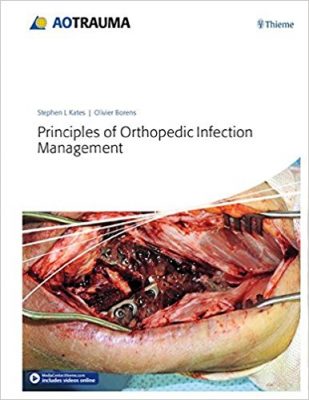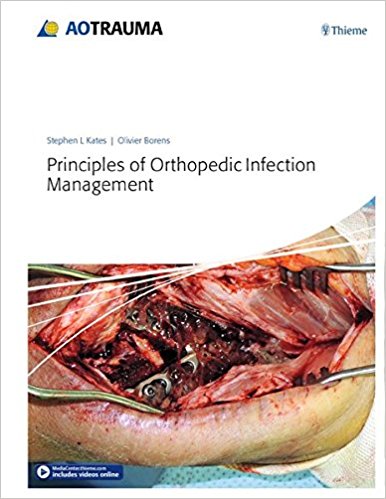 Editors: Stephen L. Kates, MD; and Olivier Borens, MD
Editors: Stephen L. Kates, MD; and Olivier Borens, MD
Publisher: Thieme – 482 pages
Book Review by: Nano Khilnani
In 1958, hip-joint replacement was a major breakthrough for physicians treating patients with osteoarthritis. But implants became a serious problem that compromised the functional results of the replacement, point out Drs. Peter Ochsner and Werner Zimmerli in their Foreword.
Hans Willeneger, one of the five founders of the AO Foundation (that publishes books such as this one), then spent quite a bit of time studying the management of complications after internal bone fixation.
He found out that the materials used in the implants as well as the bone sequesters increased susceptibility to infection. He also realized that the degree of severity of the trauma and the type of bone fixation have much to do on the pattern of bone necrosis. So the pillars of surgical treatment were then defined as:
- Debridement of necrotic bone and soft tissue
- Removal of implant material
- Osteoplastic measures such as autogenous bone grafting
When the above measures were taken and there were still some failures, such as infected nonunions, it was discovered that adding antibiotics and antiseptics failed to reliably heal posttraumatic osteomyelitis. Drs. Ochner and Zimmerli write: “Success rates remained low, the number of surgical interventions high, and late recurrence was rather frequent.”
Why was this the case? Because microorganisms persist as biofilm in implants, and are resistant to host defenses and most antimicrobial agents, some infectious disease specialists demonstrated. Based on these and other observations, treatment algorithms were developed to deal with periprosthetic joint infections and implant-associated osteomyelitis.
Correct measures are the key to treatment success in orthopedic implant-associated infection management. A dedicated team of orthopedic surgeons, infectious disease specialists, microbiologists, plastic surgeons, and pathologists is required for optimal treatment results. This is the principal message of the editors and authors of this book to the readers
Sixty-three specialists in areas related to managing infections, such as bacteriology, infectious diseases, microbiology, orthopedics, orthopedic surgery, lower extremity surgery, pathology, pediatrics, sports medicine, traumatology, upper extremity surgery, and others, from around the United States and 13 other countries – Argentina, Austria, Belgium, China, France, Germany, Hong Kong, India, Israel, Italy, South Korea, Spain, Switzerland – authored the 35 chapters of this book, which are organized around three sections namely:
- Section 1 – Principles
- Section 2 – Special Situations
- Section 3 – Cases
Besides the content found in this printed book, users can access six surgical videos by going to www.MediaCenter.Thieme.com and typing in the access code found on the inside front cover.
We have chosen to take a closer look at the contents of chapter 1 entitled Implant-Associate Biofilm found on pages 3-17. The outline of this chapter is as follows:
- Basics
- Definition of a Biofilm
- What Is Biofilm?
- Interaction Between Biofilm and Implant
- Pathogenesis of Implant-Associated Infections
- Conclusion
References: 137 sources of information for further study
The authors of this chapter – Kohei Nishitani, Karen de Mesy Bentley, and John L. Daiss – write that Total Joint Replacement (TJR) has been the treatment option for millions of patients worldwide who suffer from arthritis and other severe joint pathologies. TJR has no doubt improved the quality of life for these people, but for some, implant-associated infections have had costly and devastating consequences such as the following:
- Extensive antibiotic therapy
- Revision surgery
- Amputation of limbs (arthrodesis)
- Financial cost
- Loss to quality of life
While many species of bacteria can cause implant-associated orthopedic infections, the Staphylococci predominate, especially Staphylococcus aureus and Staphylococcus epidermidis
Some of the major challenges such bacteria pose, are that they are:
- Hard to diagnose
- Persist against antibiotic therapy
- Prone to recurrence
This chapter covers some of the main features of biofilms that have these bacteria, including how they develop, how they interact with the host’s immune response, and how they complicate detection and therapy. Images found on page 4 attest to this.
It was not until 1981 when the word biofilm was first used, so our knowledge of it is less than 35 years old. Articles written in the 1980s mentioned about the adhesion and growth of bacteria on medical devices such as indwelling catheters, orthopedic implants, pacemakers and sutures.
The chapter authors assert: “We now recognize that bacterial biofilms are now responsible for at least 65 percent of infections in humans including recurrent lung infections and diabetic wounds. In addition, we now understand that bacterial biofilms are the predominant lifestyle of bacteria in their natural aquatic or soil environments.”
They go on further to state: “Biofilms are often perceived as static fortresses where bacteria find shelter like people gathering in a castle to seek refuge from invaders. Biofilms are indeed fortresses providing shelter from immunological and medical interventions such as neutrophils and antibiotics. But this concept is far too limited. Biofilms are also dynamic communities that undergo their own lifestyle of attachment, accumulation/maturation, and dispersal.”
What about biofilms’ role in orthopedic infections? Well, we now know that they are incubators for Staphylococci. This is indeed an intriguing chapter on biofilms, just as the entire book can put you on a voyage of discovery.
There is really so much to learn in this essential, practical, keepsake guide to managing orthopedic infections. It contains critical information from 63 experts worldwide, six videos, 21 in-depth patient case examples, more than 800 illustrations, and nine algorithms to assistance in making complex decisions.
Editors:
Stephen L. Kates, MD is Professor and Chair of Orthopedic Surgery at Virginia Commonwealth University in Richmond, Virginia
Olivier Boirens, MD is Professor and Medecin chef at Unite de Traumatologie, and Unite de Chirugie Septique, Service d’Orthopedie et de Traumatologie in Lausanne, Switzerland.





